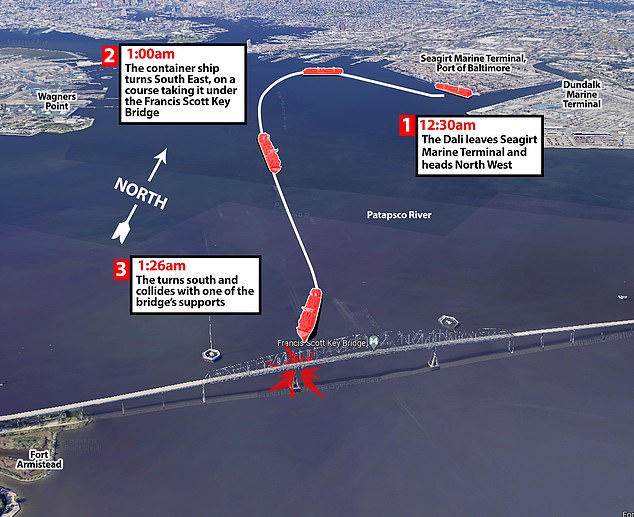Singaporean-flagged container ship Dali told Baltimore authorities it had ‘lost control’ and was heading towards the bridge moments before it smashed into support pillar and lost ‘propulsion’
- An initial report indicated that propulsion may have caused the catastrophe
Questions are being raised about how a cargo ship crashed into Baltimore’s Francis Scott Key Bridge overnight, with it believed a propulsion error may have been the cause.
The ship, a 1,000-foot DALI owned by Singapore company Synergy Group, collided with the 1.2-mile bridge shortly after 1:26 a.m. as it left the Port of Baltimore.
Officials quickly ruled out the catastrophe as intentional or an act of terrorism, raising questions about how the ship’s pilots failed to avoid the bridge.
According to an early report from the Cybersecurity and Infrastructure Security Agency (CISA), the container ship “lost propulsion” as it left port.
“The vessel notified the MD Department of Transportation (MDOT) that it had lost control of the vessel and that a collision with the bridge was possible,” the report said. ‘The ship hit the bridge and completely collapsed.’
Stunning footage shows the moment the ship plowed into Baltimore’s Francis Scott Key Bridge, sending the colossal steel structure plunging into the Patapsco River, shortly before 1:30 a.m. Eastern Time.

The bridge spans 9,000 feet over the Patapsco River and is 180 feet above the water
The investigation into the accident is still ongoing.
Professor Helen Sampson, an expert at the Seafarers International Research Center at Cardiff University, speculated that human error may also have played a role.
Because the ship crashed at 1:30 am, she said Sky News: ‘Time also makes me wonder if there was an element of fatigue at play…’
“It is almost always the case that we focus on human error at an individual level, it is almost always the case that there is a broader context that has led to those human errors, such as fatigue and the demands placed on pilots or crews.”
